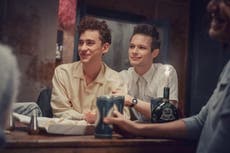The Independent's journalism is supported by our readers. When you purchase through links on our site, we may earn commission.
Less sex in real life equals more sex on our screens
It seems that now more than ever, having seen many social interactions reduced, sex on TV and in books is being used as a way to directly express our collective humanity, writes Mary Harrod

Your support helps us to tell the story
From reproductive rights to climate change to Big Tech, The Independent is on the ground when the story is developing. Whether it's investigating the financials of Elon Musk's pro-Trump PAC or producing our latest documentary, 'The A Word', which shines a light on the American women fighting for reproductive rights, we know how important it is to parse out the facts from the messaging.
At such a critical moment in US history, we need reporters on the ground. Your donation allows us to keep sending journalists to speak to both sides of the story.
The Independent is trusted by Americans across the entire political spectrum. And unlike many other quality news outlets, we choose not to lock Americans out of our reporting and analysis with paywalls. We believe quality journalism should be available to everyone, paid for by those who can afford it.
Your support makes all the difference.Once cloaked in coy innuendo, these days a raunchy chat and explicit images are all but banal. Porn websites are reporting record numbers, while the messy realities of intimacy are increasingly shown in films and on TV.
But if sex is everywhere, it’s also nowhere: as birth rates plunge globally, we are engaging in the act less and less. The significance of this change shouldn’t be underestimated, as how we conceptualise sex and relationships is at the root of how we organise our societies.
For many centuries, it was taken as a given that sexual passion lay outside the boundaries of marriage, which was instead based on the alliance of wealth. Indeed, it was often quietly tolerated for people to take lovers outside wedlock. But after the sexual revolution of the 1970s, passion was folded into socially sanctioned marriage – or long-term coupledom.
This shift has made love stories more complicated and darker – the 1977 film Annie Hall, where Annie voices dissatisfaction with an unexciting sex life and the couple ends up splitting, is an early example. More recently, the utopian romcom format – seen in the likes of Notting Hill – appears to be on the wane as we seem increasingly pessimistic about coupledom.
The paradoxical situation where meaningful intimacy is at once an object of scepticism and also a cultural obsession is the focus of my new co-edited book Imagining ‘We’ in the Age of ‘I’. The book looks at how the more dubious we seemingly are about the possibility of transcendent romance, the more we want to dream of its existence.
At the same time, while the pandemic may have exacerbated our desires for physical contact – with terms like “skin hunger” entering popular parlance – concern about the spread of “digital intimacy” has been the focus of much attention for some years.
While college freshman Brendan’s experience of porn makes him toxic, his lonely mother’s sexual reawakening through it ultimately leads to an in-person encounter that is awkward but touching
In fiction, for example, the 2019 summer bestseller Fleishman is in Trouble looks at separation in the Tinder age. A middle-aged man mourning a recent divorce alternates between gleeful perusals of female body parts sent to him online and the hopeless realisation that “all desire is death”.
A similar theme is explored in this year’s acclaimed comic satire Fake Accounts. In it, a bereaved young woman addicted to the internet engages in a series of dates with men met online – and constructs new identities for each date in the style of a dating profile. In line with what research on Tinder tends to show, none of these dates leads to any further contact and she is plagued by suicidal thoughts. The novel’s style mimics the informational barrage characteristic of web surfing to evoke the headache-inducing tempo of a life anchored by clickbait.
On TV, 2019’s Mrs Fletcher grappled with the dangers and possibilities of engaging in cybersex. While college freshman Brendan’s experience of porn makes him toxic, his lonely mother’s sexual reawakening through it ultimately leads to an in-person encounter that is awkward but touching.
In 2020 and 2021 the adaptation of Sally Rooney’s bestselling highly sexualised hetero-romance novel Normal People and Russell T Davies’ celebration of gay life and promiscuity It’s a Sin hit our screens. Both of these put primal physical attraction on a higher plane, even if it isn’t always the most pleasurable of encounters.
Normal People’s middle-class protagonist Marianne endures abusive relationships with people from her own background, while her liaison with working-class Connell is framed in terms of a “love of your life” sexual attraction. It’s much like the strong pull between Alice and Felix depicted in Rooney’s latest novel, Beautiful World Where Are You?, released this year.
Aids-epidemic story It’s a Sin is more radical than either of these narratives and not only because the show’s unfussy vision of sex extends to a character instructing another to wash their arse. At the end of the series, when protagonist Richie dies, he tells his conventional mother that the many fleeting encounters he had with relative strangers, instead of being tawdry or even regrettable, define him.
It seems that now more than ever, having seen many social interactions reduced to functionality, “brute” sex on screen and in books is being used as a way to directly express our collective humanity. Indeed, there is no longer a need for candlelight and soft music to remind us of our sexuality in a world of disappearing social bonds.
Mary Harrod is an associate professor (School of Modern Languages and Cultures) at University of Warwick. This article first appeared on The Conversation



Join our commenting forum
Join thought-provoking conversations, follow other Independent readers and see their replies
0Comments